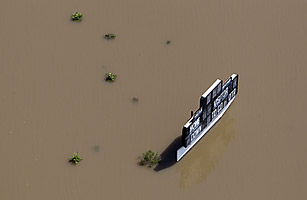
Mark Twain, the bard of the Mississippi River, was always skeptical of human efforts to control it. “Ten thousand river commissions, with the mines of the world at their back, cannot tame that lawless stream, cannot curb it or confine it, cannot say to it, ‘Go here,’ or ‘Go there,’ and make it obey,” he wrote in 1883. Twain genuinely admired “the West Point engineers” who dreamed of caging the beast. He truly wanted to believe their confident pronouncements “that they can fetter and handcuff that river and boss him.” But a life along the river convinced him that they “might as well bully the comets in their courses and undertake to make them behave, as try to bully the Mississippi into right and reasonable conduct.”
More than a century later, as the beast wreaks havoc yet again, drowning farms and towns in its natural floodplain, forcing those gung-ho Army engineers to blow up levees and fling open floodgates to try to relieve its rage, it is clear that Twain was right. And also that Twain was wrong.
It turns out that Twain underestimated the ability of the Army to confine the Mississippi with earthen levees and federal dollars. In the flood of 2011, the engineers have fought the river to a heroic standoff, holding back a wall of water that would fill 25 Olympic-size swimming pools every second. Their mainline levees along the Mississippi have held firm. Most of the damage has come from backwater flooding where smaller tributaries have mutinied against their banks. The engineers sacrificed 130,000 acres of farmland in a Missouri floodway, and they’ll sacrifice more in a Louisiana spillway, but that was always their plan for a flood this scary.
“The system is under the most stress it’s been under since it was designed,” says Army Corps of Engineers spokesman Bob Anderson. “And so far, it’s working.”
But if human beings are winning this battle against the river, a proposition that some waterlogged communities might dispute, we’re losing the war. It’s not just bad luck that the modern Mississippi seems to have a 100-year flood every few years. It’s not a coincidence that flood damage has been soaring for decades. It’s because of what we’ve done to the river, to the floodplain and maybe to the climate. This flood may turn out to be a run-of-the-mill disaster rather than an epic disaster, but as Twain always understood, Mother Nature eventually gets the last word. “We’re having disasters just about every year,” says Robert Criss, a hydrogeologist at Washington University in St. Louis. “We like to think we control the river, but who’s really in control?”
Twain’s hometown, Hannibal, Mo., illustrates how flood fighting has become an almost annual Midwestern pastime. In a 2008 paper, Criss showed that in the previous 25 years, Hannibal had endured 10 floods at levels the Army Corps of Engineers expected only once a decade, including one 500-year flood and one 200-year flood. If that sounds like a fluke, Hannibal had to fend off another 10-year flood in 2009. And another in 2010. And now this.
Water Has to Go Somewhere
The Mississippi is a really big river system. Its watershed covers two-fifths of the continental U.S., draining all or part of 31 states. In its natural state, it rambled across that floodplain every spring, nourishing wetlands and recharging aquifers before drifting back to its channel. And it had a really broad channel, nearly a mile wide at St. Louis when an Army engineer named Robert E. Lee mapped it in 1837. Today the Mississippi is a vibrant liquid highway with great cities along its banks and an agricultural empire in its 1.2 million-sq.-mi. basin. It doesn’t ramble anymore. But all that water still has to go somewhere.
The straitjacketing of the Mississippi began with an obnoxious Army engineer named Andrew Humphreys, who lost 3,000 soldiers in the charge at Fredericksburg and later marveled, “I felt more like a god than a man!” He applied the same hubris to the river, enforcing a “levees only” policy that began cutting it off from its floodplain and squeezing it into a narrower channel. Today the Mississippi at St. Louis is less than half as wide as it was in Lee’s day. Unfortunately, when more water has to stay in the tub and the walls of the tub move closer together, the water rises. In 1927, as the historian John Barry chronicled in Rising Tide, the river overwhelmed the patchwork of local levees that had sprouted along its banks, leaving a million people homeless and 16 million acres underwater.
After the deluge, the Army Corps devised a new plan that’s still in place. It’s a much better plan, providing much better protection. But it’s also helped usher in an era of ever worsening floods that keep testing its defenses.
The new plan still relied on levees, but the corps took over responsibility for building them all along the river, so that poor towns and absentee landowners would no longer be weak links. These massive levees have kept the floodplain much drier. But their effectiveness has had perverse consequences, reducing the small levee failures in rural areas that once served as involuntary relief valves for the river in flood. Bigger and better levees have also attracted more intense agriculture and development in the floodplains behind them, so there’s much more in harm’s way. And the conversion of wetlands and prairies into tile-drained farms and asphalt exurbia has increased and accelerated the runoff pouring into the river and its tributaries, diverting even more water into the tub.
See “Hell or High Water: Memphis Makes the Best of Record Flooding.”